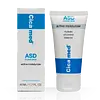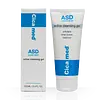What's inside
What's inside
 Key Ingredients
Key Ingredients

 Benefits
Benefits

 Concerns
Concerns

 Ingredients Side-by-side
Ingredients Side-by-side

Water
Skin ConditioningCetyl Palmitate
EmollientCetyl Alcohol
EmollientGlycerin
HumectantCaprylic/Capric Triglyceride
MaskingTridecyl Stearate
EmollientIsostearyl Alcohol
EmollientNiacinamide
SmoothingSodium PCA
HumectantSimmondsia Chinensis Seed Oil
EmollientSalicylic Acid
MaskingAloe Barbadensis Leaf Juice Powder
Skin ConditioningTridecyl Trimellitate
EmollientButylene Glycol Cocoate
EmulsifyingTocopheryl Acetate
AntioxidantSqualane
EmollientIris Florentina Root Extract
MaskingAllantoin
Skin ConditioningZinc Sulfate
AntimicrobialRetinyl Palmitate
Skin ConditioningBeta-Glucan
Skin ConditioningNeopentyl Glycol Dicaprylate/Dicaprate
EmollientXanthan Gum
EmulsifyingMaltodextrin
AbsorbentHydroxyethylcellulose
Emulsion StabilisingEthylcellulose
Hydroxyethyl Acrylate/Sodium Acryloyldimethyl Taurate Copolymer
Emulsion StabilisingPropanediol
SolventMentha Piperita Oil
MaskingCitrus Aurantium Dulcis Peel Oil Expressed
PerfumingJuniperus Virginiana Oil
MaskingCedrus Deodara Wood Oil
MaskingCedrus Atlantica Wood Oil
PerfumingPolysorbate 60
EmulsifyingAlcohol Denat.
AntimicrobialLevulinic Acid
PerfumingSodium Levulinate
Skin ConditioningSodium Phytate
Sodium Benzoate
MaskingBenzyl Alcohol
PerfumingSorbic Acid
PreservativeWater, Cetyl Palmitate, Cetyl Alcohol, Glycerin, Caprylic/Capric Triglyceride, Tridecyl Stearate, Isostearyl Alcohol, Niacinamide, Sodium PCA, Simmondsia Chinensis Seed Oil, Salicylic Acid, Aloe Barbadensis Leaf Juice Powder, Tridecyl Trimellitate, Butylene Glycol Cocoate, Tocopheryl Acetate, Squalane, Iris Florentina Root Extract, Allantoin, Zinc Sulfate, Retinyl Palmitate, Beta-Glucan, Neopentyl Glycol Dicaprylate/Dicaprate, Xanthan Gum, Maltodextrin, Hydroxyethylcellulose, Ethylcellulose, Hydroxyethyl Acrylate/Sodium Acryloyldimethyl Taurate Copolymer, Propanediol, Mentha Piperita Oil, Citrus Aurantium Dulcis Peel Oil Expressed, Juniperus Virginiana Oil, Cedrus Deodara Wood Oil, Cedrus Atlantica Wood Oil, Polysorbate 60, Alcohol Denat., Levulinic Acid, Sodium Levulinate, Sodium Phytate, Sodium Benzoate, Benzyl Alcohol, Sorbic Acid
Water
Skin ConditioningGlycerin
HumectantCocamidopropyl Betaine
CleansingCoco-Glucoside
CleansingSalicylic Acid
MaskingGlycolic Acid
BufferingHamamelis Virginiana Water
AstringentPanthenol
Skin ConditioningAloe Barbadensis Leaf Juice Powder
Skin ConditioningXanthan Gum
EmulsifyingAmmonium Acryloyldimethyltaurate/Vp Copolymer
Mentha Piperita Oil
MaskingCitrus Aurantium Dulcis Peel Oil Expressed
PerfumingJuniperus Virginiana Oil
MaskingCedrus Deodara Wood Oil
MaskingCedrus Atlantica Wood Oil
PerfumingAlcohol Denat.
AntimicrobialSodium Phytate
Sodium Hydroxide
BufferingSodium Benzoate
MaskingPotassium Sorbate
PreservativeCitric Acid
BufferingWater, Glycerin, Cocamidopropyl Betaine, Coco-Glucoside, Salicylic Acid, Glycolic Acid, Hamamelis Virginiana Water, Panthenol, Aloe Barbadensis Leaf Juice Powder, Xanthan Gum, Ammonium Acryloyldimethyltaurate/Vp Copolymer, Mentha Piperita Oil, Citrus Aurantium Dulcis Peel Oil Expressed, Juniperus Virginiana Oil, Cedrus Deodara Wood Oil, Cedrus Atlantica Wood Oil, Alcohol Denat., Sodium Phytate, Sodium Hydroxide, Sodium Benzoate, Potassium Sorbate, Citric Acid
Ingredients Explained
These ingredients are found in both products.
Ingredients higher up in an ingredient list are typically present in a larger amount.
Alcohol Denat. is an alcohol with a denaturant property. It is created by mixing ethanol with other additives.
This ingredient gets a bad rep because it is irritating and drying - mostly due to its astringent property. Astringents draw out natural oils in tissue, constricting pores and leaving your skin dried out.
However, alcohol denat. is not all that bad.
Due to its low molecular weight, alcohol denat. tends to evaporate quickly. One study on pig skin found half of applied alcohol evaporated in 10 seconds and less than 3% stayed on skin.
This also helps other ingredients become better absorbed upon application.
Studies are conflicted about whether this ingredient causes skin dehydration. One study from 2005 found adding emollients to propanol-based sanitizer decreased skin dryness and irritation. Another study found irritation only occurs if your skin is already damaged.
Small amounts of alcohol are generally tolerated by oily skin or people who live in humid environments.
The rule of thumb is if this alcohol is near the end of an ingredients list, it will probably not affect your skin much.
Also...
This ingredient has antimicrobial and solvent properties.
The antimicrobial property helps preserve products and increase their shelf life. As a solvent, it helps dissolve other ingredients.
Other types of astringent alcohols include:
Learn more about Alcohol Denat.Aloe Barbadensis Leaf Juice Powder comes from the aloe plant.
You may know Aloe to be a good sunburn reliever and inflammation reducer. This is because it contains many components that are known to help reduce irritation and itchiness.
Aloe leaves are also great moisturizers. They are naturally rich in polysaccharides, a carbohydrate made of sugars. Polysaccharides are able to mimic the carbs found in the top layer of your skin. This can help keep your skin hydrated.
Aloe contains the antioxidants Vitamins A, C, and E. These vitamins neutralize free radicals. Free-radicals are molecules that may damage your skin cells, such as pollution.
Aloe does not protect against UV rays, despite it soothing sunburns.
Learn more about Aloe Barbadensis Leaf Juice PowderCedrus Atlantica Wood Oil is a fragrance and is an oil. It can cause irritation.
Cedrus Deodara Wood Oil is an oil.
Citrus Aurantium Dulcis Peel Oil Expressed is a fragrance and is an oil.
Glycerin is already naturally found in your skin. It helps moisturize and protect your skin.
A study from 2016 found glycerin to be more effective as a humectant than AHAs and hyaluronic acid.
As a humectant, it helps the skin stay hydrated by pulling moisture to your skin. The low molecular weight of glycerin allows it to pull moisture into the deeper layers of your skin.
Hydrated skin improves your skin barrier; Your skin barrier helps protect against irritants and bacteria.
Glycerin has also been found to have antimicrobial and antiviral properties. Due to these properties, glycerin is often used in wound and burn treatments.
In cosmetics, glycerin is usually derived from plants such as soybean or palm. However, it can also be sourced from animals, such as tallow or animal fat.
This ingredient is organic, colorless, odorless, and non-toxic.
Glycerin is the name for this ingredient in American English. British English uses Glycerol/Glycerine.
Learn more about GlycerinJuniperus Virginiana Oil is the volatile oil obtained from the fruits and leaves of the Red Cedar tree. This tree is native to North America.
Mentha Piperita Oil is the volatile oil obtained from the whole plant of the Peppermint plant.
It can be used to add a fresh scent to products.
Peppermint oil may cause skin sensitivity and redness due to its menthol content. Menthol also has a cooling effect (like your toothpaste).
Learn more about Mentha Piperita OilSalicylic Acid (also known as beta hydroxy acid or BHA) is a well-known ingredient for treating skin that struggles with acne and clogged pores. It exfoliates both the skin's surface and deep within the pores to help clear out buildup, control oil, and reduce inflammation.
Unlike AHAs (alpha hydroxy acids), salicylic acid is oil-soluble. This allows it to penetrate into pores which makes it especially effective for treating blackheads and preventing future breakouts.
Salicylic acid is also known for its soothing properties. It has a similar structure to aspirin and can calm inflamed or irritated skin, making it a good option for acne-prone skin that is also sensitive.
Concentrations of 0.5-2% are recognized by the U.S. FDA as an over-the-counter topical acne product.
It can cause irritation and/or dryness if one's skin already has a compromised moisture barrier, so it's best to focus on repairing that before introducing this ingredient into your routine.
While salicylic acid does not increase sun sensitivity, it’s still important to wear sunscreen daily to protect your skin.
If you are looking for the ingredient called BHA or Butylated Hydroxyanisole, click here.
Learn more about Salicylic AcidSodium Benzoate is a preservative. It's used in both cosmetic and food products to inhibit the growth of mold and bacteria. It is typically produced synthetically.
Both the US FDA and EU Health Committee have approved the use of sodium benzoate. In the US, levels of 0.1% (of the total product) are allowed.
Sodium benzoate works as a preservative by inhibiting the growth of bacteria inside of cells. It prevents the cell from fermenting a type of sugar using an enzyme called phosphofructokinase.
It is the salt of benzoic acid. Foods containing sodium benzoate include soda, salad dressings, condiments, fruit juices, wines, and snack foods.
Studies for using ascorbic acid and sodium benzoate in cosmetics are lacking, especially in skincare routines with multiple steps.
We always recommend speaking with a professional, such as a dermatologist, if you have any concerns.
Learn more about Sodium BenzoateSodium Phytate is the synthetic salt form of phytic acid. Phytic acid is an antioxidant and can be found in plant seeds.
Sodium Phytate is a chelating agent. Chelating agents help prevent metals from binding to water. This helps stabilize the ingredients and the product.
Water. It's the most common cosmetic ingredient of all. You'll usually see it at the top of ingredient lists, meaning that it makes up the largest part of the product.
So why is it so popular? Water most often acts as a solvent - this means that it helps dissolve other ingredients into the formulation.
You'll also recognize water as that liquid we all need to stay alive. If you see this, drink a glass of water. Stay hydrated!
Learn more about WaterXanthan gum is used as a stabilizer and thickener within cosmetic products. It helps give products a sticky, thick feeling - preventing them from being too runny.
On the technical side of things, xanthan gum is a polysaccharide - a combination consisting of multiple sugar molecules bonded together.
Xanthan gum is a pretty common and great ingredient. It is a natural, non-toxic, non-irritating ingredient that is also commonly used in food products.
Learn more about Xanthan Gum